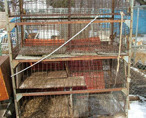 issue |
issue > puppy/kitten mills
The term "puppy mill" has evolved over the decades to reflect commercial breeding facilities of any size that have neglectful, not just egregious, conditions which harm the physical and emotional well-being of each animal. DEFINITION A "puppy mill" (applicable to kitten mill as well) is defined as:
The above definition is important to know as it highlights key points about these facilities:
*Definition above was created by Dr. Frank McMillan in Understanding and Caring for Rescued Puppy Mill Dogs, an extensive study of puppy mill dogs and puppies.
A MN breeder; was USDA-licensed; cancelled due to health reasons OVERVIEW In Minnesota, dogs and cats are legally defined as property. This definition has created an industry where certain breeders, working with auctioneers, brokers, pet stores and others, view dogs and cats as products to be mass produced and sold for profit. This mass production results in harm to animals.
MINNESOTA BREEDER PROFILES Minnesota is home to some of the largest puppy mills in the nation. Our research shows some facilities have and continue to violate the Animal Welfare Act. For profiles, go to: Commercial Breeder profiles.
|
 |
"));